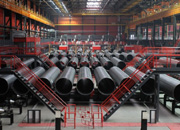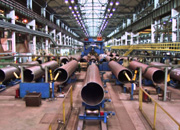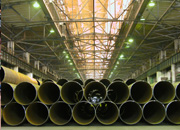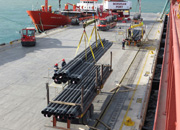The processing technology of 12Cr1MoV cold-bent alloy angle steel needs to comprehensively consider the material properties and process requirements. The key links and precautions are as follows:
First, material preparation of
12Cr1MoV alloy angle steel: obtain qualified 12Cr1MoV steel, mark and record it. This material contains certain alloy elements, and its cutting processability is slightly worse than that of ordinary carbon steel. Attention should be paid to the adjustment of process parameters.
1. Cutting and blanking:
(a) Process selection: A sawing machine, shearing machine, or laser cutting can be used. Laser cutting is suitable for thin plate processing and can obtain precise cutting quality; nitrogen should be used as protective gas during plasma cutting, and the cut should be polished.
(b) Parameter control: The cutting speed is recommended to be controlled at 80-120m/min and the feed rate is 0.1-0.3mm/r. For thicker plates, preheating to 150-200℃ can significantly improve the cutting effect.
2. Cold bending:
(a) Pretreatment requirements: impurities such as oil and rust on the surface need to be removed, and parameters such as bending angle and radius need to be determined according to design requirements.
(b) Equipment selection: Suitable molds and bending equipment should be selected, and the mold selection needs to match the steel plate thickness and bending angle.
(c) Process control: Reasonably control the bending force to avoid cracking or deformation; the bending difficulty can be reduced by appropriate heating, but the heating temperature needs to be controlled to prevent performance degradation.
3. Heat treatment:
(a) Process requirements: Annealing, normalizing, and tempering are usually used, and the lower limit of tempering temperature is 675℃. It can also be tempered after a blast or liquid quenching from the austenitizing temperature.
(b) Parameter control: Tempering temperature and holding time must be strictly implemented according to the process to ensure that the material obtains good comprehensive performance.
4. Welding process:
(a) Groove treatment: Before welding, the groove and the oil and rust within 20mm on both sides need to be thoroughly cleaned.
(b) Process parameters: preheat to 200-250℃, interlayer temperature controlled below 300℃, low hydrogen type welding rods such as E5515-B2 (such as R307) are recommended.
(c) Post-weld treatment: immediately carry out 680-720℃ tempering treatment, the holding time is calculated as 1 hour per 25mm thickness, and important structures need to be 100% radiographic or ultrasonic inspection.
(d) Finishing and surface treatment: use lathes, milling machines, grinders, and other tools for fine processing to obtain high dimensional accuracy and surface finish. Grinding, polishing, spraying, and other surface treatments can be performed as needed.
Second, inspection and quality control of 12Cr1MoV alloy angle steel:
(a) Inspection method: ultrasonic inspection, hardness testing, dimensional measurement, and other means are used.
(b) Quality standards: ensure that the product meets the design requirements and relevant standards, and pay special attention to avoiding stress concentration sources such as surface scratches or pits.
 Threeway Steel is known as a professional supplier engaged in manufacturing and distributing a wide range of steel pipe, and our headquarter located the central part of China – Hunan and six associated factories throughout China.
Threeway Steel is known as a professional supplier engaged in manufacturing and distributing a wide range of steel pipe, and our headquarter located the central part of China – Hunan and six associated factories throughout China.
 Threeway Steel is known as a professional supplier engaged in designing, manufacturing and distribution of a wide range of steel products with the headquarter located the central part of China – Hunan and six associated factories throughout China.
Threeway Steel is known as a professional supplier engaged in designing, manufacturing and distribution of a wide range of steel products with the headquarter located the central part of China – Hunan and six associated factories throughout China.
 Threeway Steel is known as a professional supplier engaged in designing, manufacturing and distribution of a wide range of steel products with the headquarter located the central part of China – Hunan and six associated factories throughout China.
Threeway Steel is known as a professional supplier engaged in designing, manufacturing and distribution of a wide range of steel products with the headquarter located the central part of China – Hunan and six associated factories throughout China.
 Threeway Steel is known as a professional supplier engaged in designing, manufacturing and distribution of a wide range of steel products with the headquarter located the central part of China – Hunan and six associated factories throughout China.
Threeway Steel is known as a professional supplier engaged in designing, manufacturing and distribution of a wide range of steel products with the headquarter located the central part of China – Hunan and six associated factories throughout China.
 Threeway Steel is known as a professional supplier engaged in designing, manufacturing and distribution of a wide range of steel products with the headquarter located the central part of China – Hunan and six associated factories throughout China.
Threeway Steel is known as a professional supplier engaged in designing, manufacturing and distribution of a wide range of steel products with the headquarter located the central part of China – Hunan and six associated factories throughout China.

